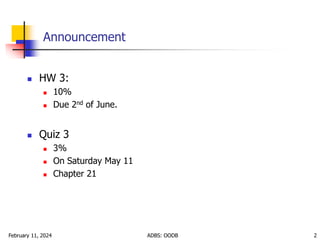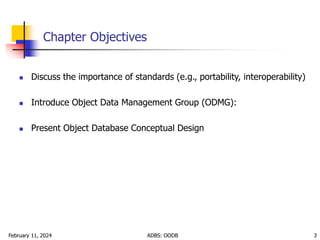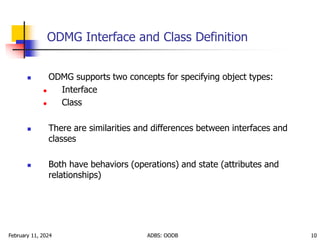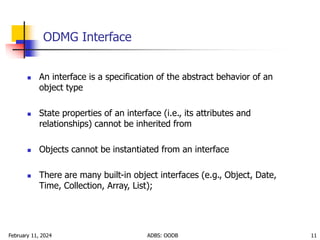Ch21-OODB.ppt
- 1. February 11, 2024 ADBS: OODB 1 Object Database Standards, Languages, and Design Chapter 21
- 2. February 11, 2024 ADBS: OODB 2 Announcement HW 3: 10% Due 2nd of June. Quiz 3 3% On Saturday May 11 Chapter 21
- 3. February 11, 2024 ADBS: OODB 3 Chapter Objectives Discuss the importance of standards (e.g., portability, interoperability) Introduce Object Data Management Group (ODMG): Present Object Database Conceptual Design
- 4. February 11, 2024 ADBS: OODB 4 Chapter Outline Advantages of Standards Overview of the Object Model ODMG The Object Definition Language DDL The Object Query Language OQL Object Database Conceptual Model
- 5. February 11, 2024 ADBS: OODB 5 - The Object Model of ODMG … One of the main reasons for the success of RDBMS is the SQL standard. Standards are essential for: Portability (ability to be executed in different systems) and Interoperability (ability to access multiple systems) As a result a consortium of ODBMS vendors formed a standard known as ODMG (Object Data Management Group)
- 6. February 11, 2024 ADBS: OODB 6 … The Object Model of ODMG The ODMG standard is made up of several parts Object module Object definition Language (ODL) Object Query Language (OQL) Bindings to O-O programming languages (OOPLs)
- 7. February 11, 2024 ADBS: OODB 7 ODMG Object Model ODMG object model: Is the data model upon which the ODL and the OQL are based Provides the data types, type constructors, and other concepts that can be utilized in the ODL to specify object database schemas Provide a standard terminology
- 8. February 11, 2024 ADBS: OODB 8 ODMG Basic Building Blocks The basic building blocks of the object model are Objects Literlas An object has four characteristics 1. Identifier: unique system-wide identifier 2. Name: unique within a particular database and/or program; it is optional 3. Lifetime: persistent vs transient 4. Structure: specifies how object is constructed by the type constructor and whether it is a collection or an atomic object
- 9. February 11, 2024 ADBS: OODB 9 ODMG Literals A literal has a current value but not an identifier Three types of literals 1. Atomic literal: predefined; basic data type values (e.g., short, float, boolean, char) 2. structured: values that are constructed by tuple constructors. (e.g., Date, Time, Interval, Timestamp, etc) 3. collection: a collection (e.g., set, list, array, bag, dictionary) of values or objects
- 10. February 11, 2024 ADBS: OODB 10 ODMG Interface and Class Definition ODMG supports two concepts for specifying object types: Interface Class There are similarities and differences between interfaces and classes Both have behaviors (operations) and state (attributes and relationships)
- 11. February 11, 2024 ADBS: OODB 11 ODMG Interface An interface is a specification of the abstract behavior of an object type State properties of an interface (i.e., its attributes and relationships) cannot be inherited from Objects cannot be instantiated from an interface There are many built-in object interfaces (e.g., Object, Date, Time, Collection, Array, List);
- 12. February 11, 2024 ADBS: OODB 12 ODMG Interface Definition Example interface Object { … boolean same_as(in object other_object); Object copy(); Void delete(); }; Note: interface is ODMG’s keyword for class/type
- 13. February 11, 2024 ADBS: OODB 13 Built-in Interfaces for Date Objects Example interface Date:Object { enum weekday{sun,mon,tue,wed,thu,fri,sat}; enum Month{jan,feb,mar,…,dec}; unsigned short year(); unsigned short month(); unsigned short day(); … boolean is_equal(in Date other_date); };
- 14. February 11, 2024 ADBS: OODB 14 Built-in Interfaces for Collection Objects A collection object inherits the basic collection interface, for example: cardinality() is_empty() insert_element() remove_element() contains_element() create_iterator()
- 15. February 11, 2024 ADBS: OODB 15 Collection Types Collection objects are further specialized into types like a set, list, bag, array, and dictionary Each collection type may provide additional interfaces, for example, a set provides: create_union() create_difference() is_subst_of() is_superset_of() is_proper_subset_of()
- 16. February 11, 2024 ADBS: OODB 16 Object Inheritance Hierarchy Built-in interfaces of the object module
- 17. February 11, 2024 ADBS: OODB 17 ODMG Class A class is a specification of abstract behavior and state of an object type A class is Instantiable Supports “extends” inheritance to allow both state and behavior inheritance among classes. Unlike interface in which only behavior is inherited. Multiple inheritance via “extends” is not allowed
- 18. February 11, 2024 ADBS: OODB 18 Atomic Objects Atomic objects are user-defined objects and are defined via keyword class An example: class Employee (extent all_emplyees key ssn) { attribute string name; attribute string ssn; attribute short age; relationship Dept works_for; void reassign(in string new_name); }
- 19. February 11, 2024 ADBS: OODB 19 Class Extents An ODMG object can have an extent defined via a class declaration Each extent is given a name and will contain all persistent objects of that class For Employee class, for example, the extent is called all_employees This is similar to creating an object of type Set<Employee> and making it persistent
- 20. February 11, 2024 ADBS: OODB 20 Class Key A class key consists of one or more unique attributes For the Employee class, the key is ssn. Thus each employee is expected to have a unique ssn Keys can be composite, e.g., (key dnumber, dname)
- 21. February 11, 2024 ADBS: OODB 21 Object Factory An object factory is used to generate individual objects via its operations An example: interface ObjectFactory { Object new (); }; new() returns new objects with an object_id One can create their own factory interface by inheriting the above interface
- 22. February 11, 2024 ADBS: OODB 22 Object Definition Language (ODL) ODL supports semantics constructs of ODMG ODL is independent of any programming language ODL is used to create object specification (classes and interfaces) ODL is not used for database manipulation, OQL is.
- 23. February 11, 2024 ADBS: OODB 23 Graphical notation for representing ODL schemas Person-IF Student Interface Class relationships inheritance 1:1 1:N M:N Interface(is-a) inheritance using “:” Class inheritance using extends object specification
- 24. February 11, 2024 ADBS: OODB 24 A graphical ODB schema for UNIVERSITY database Person Department Course Section CurrSection Student Gradstudent Faculty registered_students committee advisor advises In_committee_of Work_in Has_majors Has_faculty offers Offered_by Has_sections students Of_course Major_in Completed_sections Registered_in
- 25. February 11, 2024 ADBS: OODB 25 ODL Examples (1): A Very Simple Class class Degree { attribute string college; attribute string degree; attribute string year; }; (all examples are based on the university schema presented in Chapter 4 and graphically shown on page 680):
- 26. February 11, 2024 ADBS: OODB 26 ODL Examples (2): A Class With Key and Extent A class definition with “extent”, “key”, and more elaborate attributes; still relatively straightforward class Person (extent persons key ssn) { attribute struct Pname {string fname …} name; attribute string ssn; attribute date birthdate; … short age(); }
- 27. February 11, 2024 ADBS: OODB 27 ODL Examples (3): A Class With Relationships Note extends (inheritance) relationship Also note “inverse” relationship Class Faculty extends Person (extent faculty) { attribute string rank; attribute float salary; attribute string phone; … relationship Dept works_in inverse Dept::has_faculty; relationship set<GradStu> advises inverse GradStu::advisor; void give_raise (in float raise); void promote (in string new_rank); };
- 28. February 11, 2024 ADBS: OODB 28 Graphical schema for geometric objects GeometryObject Triangle Circle Triangle ... interface GeometryObject { attribute enum Shape{Rectangle,Triangle, Circle,…}shape; attribute struct Point {short x, short y} reference_point; float perimeter(); float area(); void translate(in short x_translation; in short y_translation); void rotate(in float angle_of_rotation); }; only operations are inherited, not properties as a result noninstantiable
- 29. February 11, 2024 ADBS: OODB 29 Inheritance via “:” – An Example interface GeometryObject { attribute struct point {…} reference_point; float perimeter (); … }; class Triangle : GeometryObject (extent triangles) { attribute short side_1; attribute short side_2; … };
- 30. February 11, 2024 ADBS: OODB 30 Object Query Language OQL is DMG’s query language OQL works closely with programming languages such as C++ Embedded OQL statements return objects that are compatible with the type system of the host language OQL’s syntax is similar to SQL with additional features for objects
- 31. February 11, 2024 ADBS: OODB 31 Object Query Language (OQL) basic OQL syntax select … from … where … Retrieve the names of all departments in the college of ‘Engineering’ Q0: SELECT d.dname FROM d in departments WHERE d.college = ‘Engineering’; How to refer to a persistent object? Entry point (named persistent object; or name of the extent of a class) iterator variable extent name d in departments departments d departments as d
- 32. February 11, 2024 ADBS: OODB 32 Data Type of Query Results The data type of a query result can be any type defined in the ODMG model A query does not have to follow the select…from…where… format A persistent name on its own can serve as a query whose result is a reference to the persistent object Example departments; whose output is set<Departments>
- 33. February 11, 2024 ADBS: OODB 33 Path Expressions A path expression is used to specify a path to attributes and objects in an entry point A path expression starts at a persistent object name (or its iterator variable) The name will be followed by zero or more dot connected relationship or attribute names, e.g., departments.chair;
- 34. February 11, 2024 ADBS: OODB 34 Views as Named Objects The define keyword in OQL is used to specify an identifier for a named query The name should be unique; if not, the results will replace an existing named query Once a query definition is created, it will persist until deleted or redefined A view definition can include parameters
- 35. February 11, 2024 ADBS: OODB 35 An Example of OQL View A view to include students in a department who have a minor: define has_minor(dept_name) as select s from s in students where s.minor_in.dname=dept_name has_minor can now be used in queries
- 36. February 11, 2024 ADBS: OODB 36 Single Elements from Collections An OQL query returns a collection OQL’s element operator can be used to return a single element from a singleton collection that contains one element: element (select d from d in departments where d.dname = ‘Software Engineering’); If d is empty or has more than one elements, an exception is raised
- 37. February 11, 2024 ADBS: OODB 37 Collection Operators OQL supports a number of aggregate operators that can be applied to query results The aggregate operators include min, max, count, sum, and avg and operate over a collection count returns an integer; others return the same type as the collection type
- 38. February 11, 2024 ADBS: OODB 38 An Example of an OQL: Aggregate Operator To compute the average GPA of all seniors majoring in Business: avg ( select s.gpa from s in students where s.class = ‘senior’ and s.majors_in.dname =‘Business’);
- 39. February 11, 2024 ADBS: OODB 39 Membership and Quantification OQL provides membership and quantification operators: (e in c) is true if e is in the collection c (for all e in c: b) is true if all e elements of collection c satisfy b (exists e in c: b) is true if at least one e in collection c satisfies b
- 40. February 11, 2024 ADBS: OODB 40 An Example of Membership To retrieve the names of all students who completed ICS102: select s.name.fname s.name.lname from s in students where ‘ICS102’ in (select c.name from c in s.completed_sections.section.of_course);
- 41. February 11, 2024 ADBS: OODB 41 Ordered Collections Collections that are lists or arrays allow retrieving their first, last, and ith elements OQL provides additional operators for extracting a sub- collection and concatenating two lists OQL also provides operators for ordering the results
- 42. February 11, 2024 ADBS: OODB 42 An Example of Ordered Operation To retrieve the last name of the faculty member who earns the highest salary: first (select struct (faculty: f.name.lastname,salary f.salary) from f in faculty ordered by f.salary desc);
- 43. February 11, 2024 ADBS: OODB 43 Grouping Operator OQL also supports a grouping operator called group by To retrieve average GPA of majors in each department having >100 majors: select deptname, avg_gpa: avg (select p.s.gpa from p in partition) from s in students group by deptname: s.majors_in.dname having count (partition) > 100
- 44. February 11, 2024 ADBS: OODB 44 Object Database Conceptual Design Object Database (ODB) vs Relational Database (RDB) Relationships are handled differently Inheritance is handled differently Operations in OBD are expressed early on since they are a part of the class specificaiton
- 45. February 11, 2024 ADBS: OODB 45 Relationships: ODB vs RDB (1) Relationships in ODB: relationships are handled by reference attributes that include OIDs of related objects single and collection of references are allowed references for binary relationships can be expressed in single direction or both directions via inverse operator
- 46. February 11, 2024 ADBS: OODB 46 Relationships: ODB vs RDB (2) Relationships in RDB: Relationships among tuples are specified by attributes with matching values (via foreign keys) Foreign keys are single-valued M:N relationships must be presented via a separate relation (table)
- 47. February 11, 2024 ADBS: OODB 47 Inheritance Relationship in ODB vs RDB Inheritance structures are built in ODB (and achieved via “:” and extends operators) RDB has no built-in support for inheritance relationships; there are several options for mapping inheritance relationships in an RDB (see Chapter 7)
- 48. February 11, 2024 ADBS: OODB 48 Early Specification of Operations Another major difference between ODB and RDB is the specification of operations ODB: operations specified during design (as part of class specification) RDB: may be delayed until implementation
- 49. February 11, 2024 ADBS: OODB 49 Mapping EER Schemas to ODB Schemas Mapping EER schemas into ODB schemas is relatively simple especially since ODB schemas provide support for inheritance relationships Once mapping has been completed, operations must be added to ODB schemas since EER schemas do not include an specification of operations
- 50. February 11, 2024 ADBS: OODB 50 Mapping EER to ODB Schemas Step 1: Create an ODL class for each EER entity type or subclass Multi-valued attributes are declared by sets, bags or lists constructors Composite attributes are mapped into tuple constructors
- 51. February 11, 2024 ADBS: OODB 51 Mapping EER to ODB Schemas Step 2: Add relationship properties or reference attributes for each binary relationship into the ODL classes participating in the relationship Relationship cardinality: single-valued for 1:1 and N:1 directions; set-valued for 1:N and M:N directions Relationship attributes: create via tuple constructors
- 52. February 11, 2024 ADBS: OODB 52 Mapping EER to ODB Schemas Step 3: Add appropriate operations for each class Operations are not available from the EER schemas; original requirements must be reviewed Corresponding constructor and destructor operations must also be added
- 53. February 11, 2024 ADBS: OODB 53 Mapping EER to ODB Schemas Step 4: Specify inheritance relationships via extends clause An ODL class that corresponds to a sub-class in the EER schema inherits the types and methods of its super-class in the ODL schemas Other attributes of a sub-class are added by following Steps 1-3
- 54. February 11, 2024 ADBS: OODB 54 Mapping EER to ODB Schemas Step 5: Map weak entity types in the same way as regular entities Weak entities that do not participate in any relationships may alternatively be presented as composite multi-valued attribute of the owner entity type
- 55. February 11, 2024 ADBS: OODB 55 Mapping EER to ODB Schemas Step 6: Map categories (union types) to ODL The process is not straightforward May follow the same mapping used for EER-to-relational mapping: Declare a class to represent the category Define 1:1 relationships between the category and each of its super-classes
- 56. February 11, 2024 ADBS: OODB 56 Mapping EER to ODB Schemas Step 7: Map n-ary relationships whose degree is greater than 2 Each relationship is mapped into a separate class with appropriate reference to each participating class
- 57. February 11, 2024 ADBS: OODB 57 END
























































